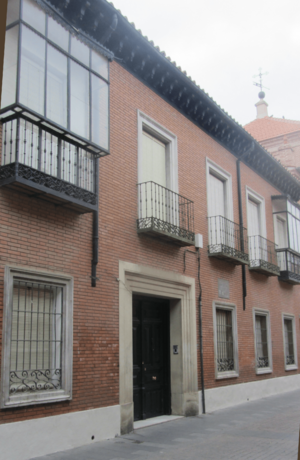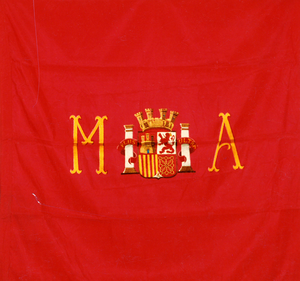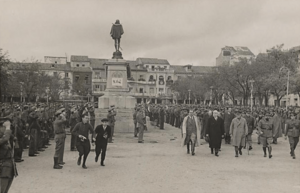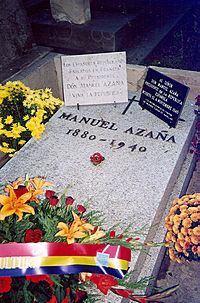Manuel Azaña facts for kids
Quick facts for kids
Manuel Azaña
|
|
|---|---|
 |
|
| President of Spain | |
| In office 7 April 1936 – 3 March 1939 |
|
| Prime Minister |
|
| Preceded by | Niceto Alcalá-Zamora |
| Succeeded by | Francisco Franco (Caudillo of Spain) |
| Prime Minister of Spain | |
| In office 19 February 1936 – 10 May 1936 |
|
| President | Niceto Alcalá-Zamora |
| Preceded by | Manuel Portela Valladares |
| Succeeded by | Santiago Casares Quiroga |
| In office 14 October 1931 – 12 September 1933 |
|
| President | Niceto Alcalá-Zamora |
| Preceded by | Juan Bautista Aznar Cabañas |
| Succeeded by | Alejandro Lerroux |
| Minister of War | |
| In office 14 April 1931 – 12 September 1933 |
|
| Preceded by | Dámaso Berenguer |
| Succeeded by | Juan José Rocha García |
| Member of the Congress of Deputies | |
| In office 16 March 1936 – 31 March 1939 |
|
| Constituency | Madrid |
| In office 8 December 1933 – 7 January 1936 |
|
| Constituency | Vizcaya |
| In office 14 July 1931 – 9 October 1933 |
|
| Constituency | Valencia |
| Personal details | |
| Born |
Manuel Azaña Díaz
10 January 1880 Alcalá de Henares, Madrid, Kingdom of Spain |
| Died | 3 November 1940 (aged 60) Montauban, Midi-Pyrénées, Vichy France |
| Political party | Republican Left (1934–1940) |
| Other political affiliations |
Republican Action (1930–1934) |
| Spouse | Dolores de Rivas Cherif |
| Occupation | Jurist |
| Signature | |
Manuel Azaña Díaz (born January 10, 1880 – died November 3, 1940) was an important Spanish politician. He served as Prime Minister and later as the last President of the Second Spanish Republic. He was a key leader for the Republic during the Spanish Civil War (1936–1939).
Azaña was also a writer. He believed in democracy and followed ideas from the French Enlightenment. He thought a country should treat all its citizens equally under the law. This led him to support a republic, where the people elect their leaders.
After the Second Spanish Republic started in 1931, Azaña became the Minister of War. He worked to make the army more modern. He later became Prime Minister in October 1931.
The Spanish Civil War began while he was President. When the Republic lost in 1939, he went to France. He resigned from his position and died in exile a year later at age 60.
Contents
Early Life and Career

Manuel Azaña Díaz was born into a wealthy family. He became an orphan at a very young age. He studied law at several universities in Spain. He earned his law degree in 1897 and a doctorate in 1900.
In 1909, he started working as a civil law notary. He traveled to Paris in 1911. He became interested in politics and joined the Reformist Republican Party in 1914. He also wrote for newspapers like El Imparcial and El Sol.
During World War I, he reported on the war from the Western Front. He wrote in a way that supported France. Later, he edited magazines like Pluma and España. In 1926, he started the Acción Republicana party.
Azaña strongly criticized the dictator Primo de Rivera and King Alfonso XIII. In 1930, he signed the "Pact of San Sebastián". This agreement united republican parties against the dictator and the king.
In April 1931, republican candidates won many local elections. This showed that people wanted an end to the monarchy. Two days later, the Second Spanish Republic was declared, and the king left Spain.
Becoming a Government Leader
Niceto Alcalá-Zamora, who was the prime minister of the new government, made Azaña the Minister of War in April 1931. When Alcalá-Zamora resigned in October, Azaña became prime minister. After the new constitution was approved, Azaña continued as prime minister. He led a group of left-wing parties.
Azaña started many important changes. He introduced insurance for work accidents. He also made the Spanish Army smaller and removed some officers who supported the monarchy. He worked to reduce the power of the Roman Catholic Church. He closed Church-run schools and charities. He also opened many state-run schools that were not religious.
The Spanish parliament, called the Cortes, also passed a law about land. This law aimed to take large private landholdings and give them to poor farmers. However, Azaña was not a socialist. His government did not fully support this program. Only a small number of families received land in the first two years.
Azaña's government also did not change the tax system much. It continued to support factory owners against worker strikes. There were violent clashes with workers, especially the anarcho-syndicalists.
Many moderate people were upset by Azaña's strong anti-Church policies. In local elections in 1933, conservative parties won most seats. Azaña faced challenges from both the right and the far left. He resigned in September 1933. New elections were held in November 1933.
These elections were won by right-wing and centrist parties. Alejandro Lerroux became prime minister. Azaña stepped away from politics for a short time.
In 1934, Azaña started a new party called the Republican Left. In October 1934, some left-wing groups tried to start a rebellion. Azaña was in Barcelona at the time. The government tried to blame him for the rebellion.
Azaña was not involved in the rebellion. The attempts to convict him failed. This made him seem like a hero to many people. He was released from prison in January 1935. Azaña then helped create the Frente Popular ("Popular Front"). This was a group of all the main left-wing parties for the elections in February 1936.
The Popular Front won the election. Azaña became prime minister again in February 1936. His government included Socialists and Communists. This worried conservatives. Azaña's government immediately released all prisoners from the 1934 rebellion. This also increased conservative concerns.
Farmers, led by Socialists, began taking over land in March. Azaña decided to allow these actions instead of stopping them. Political violence increased. There were many killings by different political groups. Azaña believed the danger to the Republic came from the right. In March, his government banned the Falange party.
Azaña was a man with very strong beliefs. He was against the monarchy and the Church. He saw parties that supported the Church as not legitimate. Historians note that those who opposed the Republic strongly disliked Azaña.
President During the Civil War
In April 1936, the parliament removed President Alcalá-Zamora from office. On April 7, 1936, Azaña was elected President of the Republic. His ally, Quiroga, became prime minister. Azaña was very worried about the growing disorder in the country.
Azaña often warned that the government's lack of unity was a big threat. Political violence continued to increase.
By July, military leaders were planning to overthrow the Republic. On July 13, José Calvo Sotelo, a monarchist leader, was killed. Azaña and Quiroga did not act quickly against the killers.
On July 17, right-wing military groups tried to overthrow the Republic. The rebellion failed in Madrid. Azaña replaced Quiroga with Diego Martínez Barrio as prime minister. The government tried to make a deal with the rebels, but General Mola refused. This marked the start of the Spanish Civil War.
In 1938, Azaña moved to Barcelona with the government. He became cut off when the Nationalist forces reached the sea.
When Barcelona fell to the rebels in January 1939, Azaña fled to France. He crossed the Pyrenees mountains on foot in February 1939.
On March 3, he resigned as President of the Republic. He chose not to return to Madrid with the rest of the government. Some people criticized this decision.
Final Days in Exile
Azaña lived in France for over a year after the war ended. He was trapped there when Germany invaded France. He died on November 3, 1940, in Montauban, France.
He received Catholic last rites before his death. The French authorities would not allow his coffin to be covered with the Spanish Republican flag. Instead, it was covered with the flag of Mexico. The Mexican government had given him Mexican citizenship and made him an Honorary Ambassador. This gave him diplomatic protection. His home was considered part of the Mexican Embassy. This helped him avoid being arrested and sent back to Spain.
His Writings
Azaña kept detailed diaries and wrote memoirs. In these writings, he described the disagreements among Republican leaders. His writings from the Civil War are important for understanding how the Republican government worked. He also wrote famous speeches. In a speech on July 18, 1938, he asked Spaniards to seek peace and forgiveness after the war.
Azaña also wrote a play during the Civil War called La velada en Benicarló ("Vigil in Benicarló"). In this play, he used different characters to show the many political and social ideas within the Republic during the war. He explored the conflicts that were hurting the Republic's unity.
His complete diaries, Diarios completos: monarquía, república, Guerra Civil, were published after his death in 2003.
Political Impact
Manuel Azaña was a leading Republican politician. He was a well-educated writer who wanted to free Spain from the power of the church and the king. He was a brilliant speaker.
As prime minister, he aimed to create a welfare state. This would include minimum wage, sickness benefits, and paid holidays. However, he did not fully address the problem of poverty among farmers. He was careful with the budget and reduced land redistribution.
He worked effectively to create a non-religious state. He ended the Catholic Church's control over education. He made civil marriage legal and took over some Catholic properties. He also expelled the Jesuit order.
As opposition grew, he censored the press and sent some opponents to North Africa. He also formed a special police force called the Assault Guards. Azaña tried to reform the army by updating equipment and closing a military academy. During this time, he demoted Francisco Franco, who later became a powerful general.
Azaña lost the elections in November 1933. He had upset extremists and lost the support of moderates. He made a comeback in 1936. However, he could not keep his political group united when the Civil War began. In recent years, he has become a hero for left-wing groups in Spain.
Images for kids
See also
 In Spanish: Manuel Azaña para niños
In Spanish: Manuel Azaña para niños





